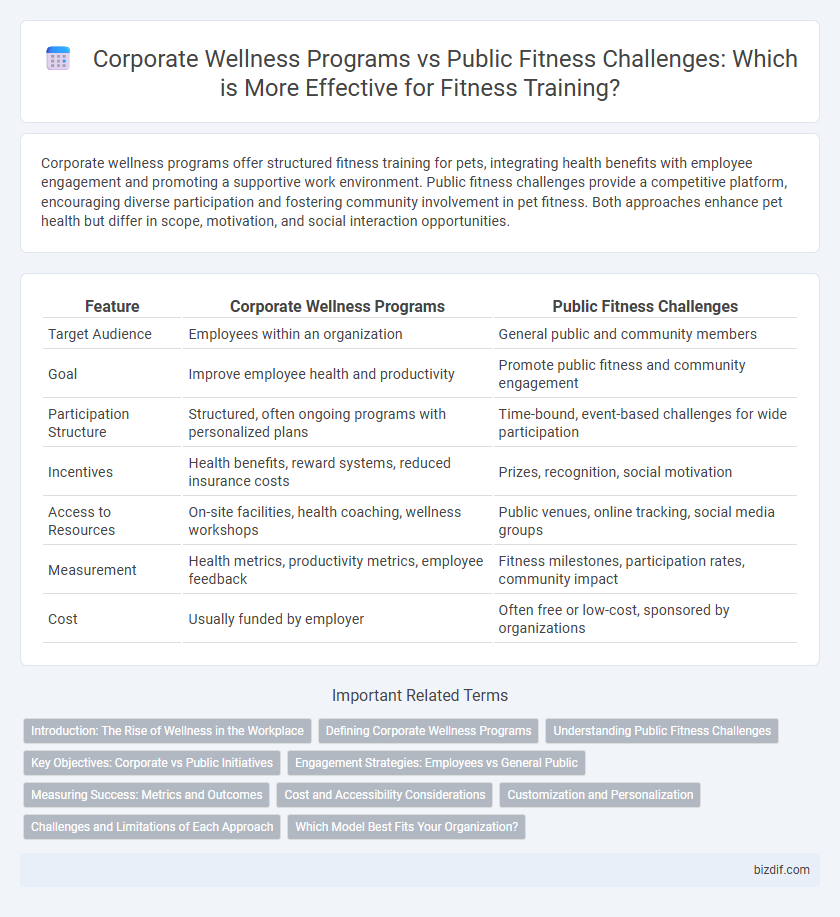Corporate wellness programs offer structured fitness training for pets, integrating health benefits with employee engagement and promoting a supportive work environment. Public fitness challenges provide a competitive platform, encouraging diverse participation and fostering community involvement in pet fitness. Both approaches enhance pet health but differ in scope, motivation, and social interaction opportunities.
Table of Comparison
| Feature | Corporate Wellness Programs | Public Fitness Challenges |
|---|---|---|
| Target Audience | Employees within an organization | General public and community members |
| Goal | Improve employee health and productivity | Promote public fitness and community engagement |
| Participation Structure | Structured, often ongoing programs with personalized plans | Time-bound, event-based challenges for wide participation |
| Incentives | Health benefits, reward systems, reduced insurance costs | Prizes, recognition, social motivation |
| Access to Resources | On-site facilities, health coaching, wellness workshops | Public venues, online tracking, social media groups |
| Measurement | Health metrics, productivity metrics, employee feedback | Fitness milestones, participation rates, community impact |
| Cost | Usually funded by employer | Often free or low-cost, sponsored by organizations |
Introduction: The Rise of Wellness in the Workplace
Corporate wellness programs have become a strategic investment for companies aiming to enhance employee health, reduce healthcare costs, and boost productivity. Public fitness challenges offer community-driven motivation and foster social engagement, but corporate programs provide structured support tailored to workplace needs. Emphasizing personalized health plans, on-site fitness resources, and regular progress tracking distinguishes corporate wellness initiatives in promoting sustained employee well-being.
Defining Corporate Wellness Programs
Corporate wellness programs are structured initiatives implemented by organizations to promote employee health, focusing on improving productivity, reducing healthcare costs, and enhancing workplace morale. These programs typically include health screenings, fitness activities, nutrition education, and stress management resources tailored to employees' needs. Unlike public fitness challenges, corporate wellness programs emphasize long-term behavioral change within a controlled organizational environment.
Understanding Public Fitness Challenges
Public fitness challenges engage diverse participants by promoting community-driven health goals through accessible, often digitally-tracked activities like step counts or workout completion. These challenges increase motivation through social accountability and real-time progress sharing, fostering a competitive yet supportive environment. Unlike corporate wellness programs, which focus on employee health benefits within an organizational framework, public fitness challenges emphasize broad inclusion and public health awareness.
Key Objectives: Corporate vs Public Initiatives
Corporate wellness programs primarily aim to enhance employee health, reduce healthcare costs, and boost productivity through tailored fitness activities within the workplace. Public fitness challenges focus on community engagement, promoting widespread physical activity and raising awareness about healthy lifestyles across diverse populations. Both initiatives target improved health outcomes but differ in their approach, with corporate programs emphasizing organizational benefits and public challenges fostering societal participation.
Engagement Strategies: Employees vs General Public
Corporate wellness programs leverage personalized engagement strategies such as tailored fitness plans, progress tracking, and incentive-based rewards to motivate employees, enhancing participation and long-term commitment. Public fitness challenges rely on broad-reaching tactics like social media campaigns, community events, and gamification to attract diverse participants and foster a sense of collective achievement. Employee-focused programs benefit from integration with workplace culture and direct management support, whereas public challenges emphasize mass appeal and inclusivity to sustain motivation across varied demographics.
Measuring Success: Metrics and Outcomes
Corporate wellness programs often measure success through employee participation rates, health risk assessments, and reductions in healthcare costs, while public fitness challenges typically track engagement numbers, completion rates, and community impact. Key metrics for corporate programs include productivity improvements and absenteeism reduction, whereas public challenges emphasize social media reach and participant feedback. Both approaches utilize biometric data and qualitative surveys to evaluate overall health outcomes and behavioral changes.
Cost and Accessibility Considerations
Corporate wellness programs often provide structured fitness training with subsidized costs for employees, making them more accessible within the workplace environment. Public fitness challenges typically require participants to cover registration fees and equipment expenses independently, which can limit accessibility for some individuals. Cost efficiency and ease of access make corporate wellness initiatives a more practical option for sustained fitness engagement compared to public challenges.
Customization and Personalization
Corporate wellness programs offer customized fitness plans tailored to employee needs, incorporating health assessments and personalized coaching for improved engagement and productivity. Public fitness challenges provide standardized activities designed for broad participation but lack individual-specific adjustments, limiting personalized progress tracking. Emphasizing customization in corporate wellness leads to higher adherence and measurable health outcomes compared to generic public fitness initiatives.
Challenges and Limitations of Each Approach
Corporate wellness programs often face challenges such as limited employee engagement, budget constraints, and difficulty measuring long-term health outcomes. Public fitness challenges struggle with inconsistent participation, varied individual fitness levels, and a lack of personalized support. Both approaches require strategic planning to overcome these limitations and maximize overall effectiveness in promoting health and wellness.
Which Model Best Fits Your Organization?
Corporate wellness programs offer tailored fitness training and health initiatives designed to improve employee productivity and reduce healthcare costs, making them ideal for companies seeking long-term engagement. Public fitness challenges encourage community participation and motivation through competitive and social elements, suited for organizations aiming to foster team spirit and external brand visibility. Evaluating your organization's size, culture, and wellness goals can determine whether the personalized approach of corporate programs or the inclusive nature of public challenges best enhances employee well-being and organizational performance.
Corporate wellness programs vs Public fitness challenges Infographic

 bizdif.com
bizdif.com